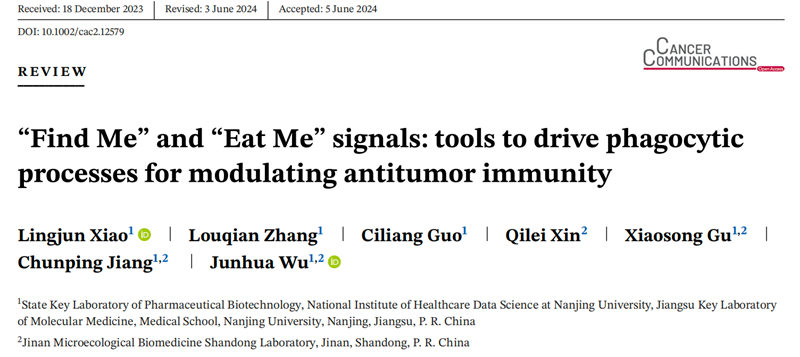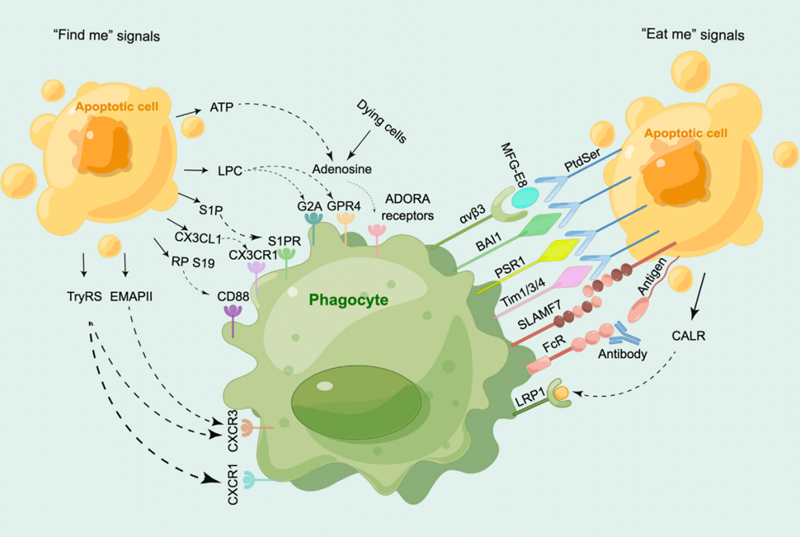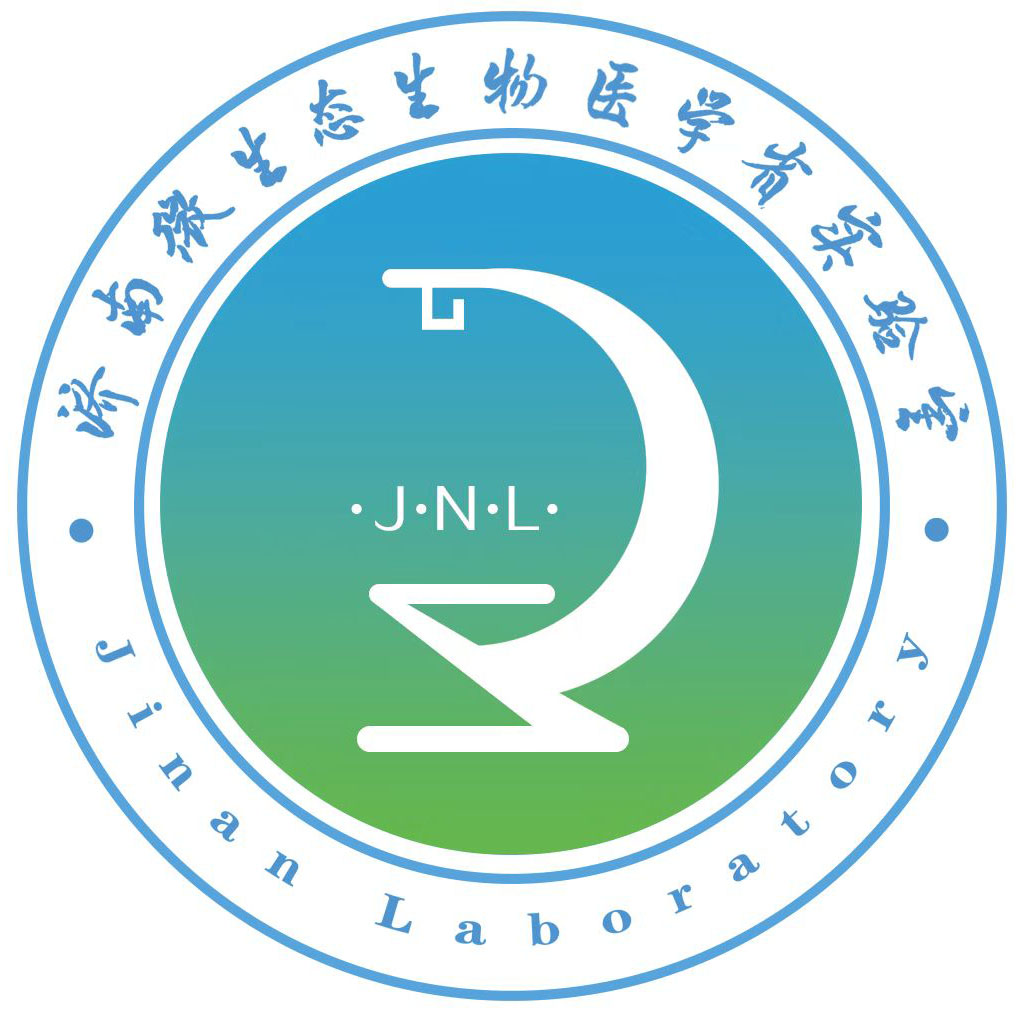Recently, Academician Xiaosong Gu, Deputy Director of Jinan Laboratory, Prof Chunping Jiang, and Prof Junhua Wu's team from Microecology and Regenerative Medicine and Tissue Engineering Microfabrication Technology Platform published an important paper titled "Find Me" and "Eat Me" signals: tools to drive phagocytic processes for modulating antitumor" in Cancer communications (CAS I, IF: 20.1). A systematic review entitled "Find Me" and "Eat Me" signals: tools to drive phagocytic processes for modulating antitumor immunity was published in Cancer communications (CAS, Region I, IF: 20.1). This review comprehensively explores the role of find me and eat me signals in tumour development and further explores how the "don't eat me" signals can be blocked by modulating "find me" and "eat me" signals and by blocking the "don't eat me" signals. The role of phagocytes in tumour development is further explored through strategies to modulate "find me" and "eat me" signalling, block "don't eat me" signalling, and combine with other therapeutic approaches to enhance anti-tumour immune responses.

Phagocytes comprise 2 main types, the mononuclear phagocyte system and neutrophils, and their binding and uptake of dying cells can significantly influence the immune response. Phagocytes exercise phagocytosis in three main steps, i.e., phagocytic target discovery (find me), phagocytosis (eat me), and digestion (digest me).
The "find me" signals recognised by phagocytes include nucleotides (e.g., ATP, UTP), membrane lipids (e.g., sphingosine phosphate), chemokines (e.g., CX3CL1), and polyamines, etc. These signals not only attract phagocytes to reach the location of apoptotic cells, but also enable phagocytes to prepare for "battle". These signals not only attract phagocytes to the location of apoptotic cells, but also prepare phagocytes for "battle", e.g. by enhancing the expression of phagocytic receptors and digestive mechanisms.
The "eat me" signals recognised by phagocytes include calreticulin, SLAMF7, FcR and phosphatidylserine, etc. After phagocytes migrate to the vicinity of apoptotic cells, the surface receptors recognise and bind to the apoptotic cell's "eat me" signals. After the phagocytes migrate near the apoptotic cells, the surface receptors recognise and bind to the "eat me" signals of the apoptotic cells to perform phagocytosis and promote cell clearance and tissue repair.
In addition, tumour cells often express "don't eat me" signals on their surface, including CD47, PD-L1, MHC-I and CD24, which prevent phagocytosis.
The "find me", "eat me" and "don't eat me" signals have immunomodulatory functions, and these signals can affect the phagocytic activity of macrophages and regulate the response of macrophages to tumours. These signals can affect the phagocytic activity of macrophages and regulate the phagocytosis of tumours by macrophages, and the regulation of these signals can provide ideas for cancer therapy.

Tips for introducing "find me" and "eat me" signals
The "find me" signals include ATP, LPC, S1P, CX3CL1, RP S19, TryRS, and EMAPII, which interact with P2Y2, GPR4, S1PR1-5, CX3CR1, CD88, CXCR1/CXCR3, and CXCR3 receptors, respectively, on macrophages. CXCR3 receptors.ATP induces phagocyte migration via P2Y2 receptors and LPC binds GPR4 to induce macrophage migration.TG2 acts as a chemokine by cross-linking RP S19 monomers, and CD88 senses RP S19-mediated monocyte migration.CX3CL1 is dependent on the chemotactic effect of CX3CR1 on phagocytes. Upon protein hydrolysis, EMAPII and TryRS display chemotactic properties, where EMAPII may be produced by caspase-7 cleavage and promotes endothelial progenitor cell migration via CXCR3, while TryRS is produced by elastase from neutrophils and stimulates phagocyte migration via CXCR1 and CXCR3.
"Eat me" signalling includes CALR, SLAMF7, Fc and PtdSer, whose receptors are LRP1 (CD91), CRACC (CD319), FcR and PSR, respectively. cell-surface CALR binds to low-density lipoprotein receptor-related protein 1 (LRP1) on phagocytes binding, which may recruit GULP1 to further regulate phagocytosis. SLAM family member 7 (SLAMF7) on macrophages binds to macrophage antigen 1 (MAC-1), which interacts with the Fc receptor common gamma chain (FCRγ) and DNAX activating protein 12 (DAP12) to recruit the Src family kinases Syk and Btk, thereby promoting phagocytosis. Macrophages express Fcγ receptors (FcγRIIb, FcγRI, FcγRIIIa and FcγRIIa), and cross-linking of FcγRs with IgG immune complexes triggers ITAM phosphorylation and activation of SYK, SRC, and PKC pathways, leading to actin remodelling, which is essential for phagocytosis of IgG immune complexes.
This study was supported by the Shandong Provincial Laboratory Project (No. SYS202202), the National Natural Science Foundation of China (No. 81972888, 82272819), the Provincial Key Research and Development Programme (No. BE2018701, BE2022840), and the Scientific Research Project of Jinan Provincial Laboratory of Microecology and Biomedicine (No. JNL2022004A, JNL2022019B). JNL2022019B, JNL2022017D).





